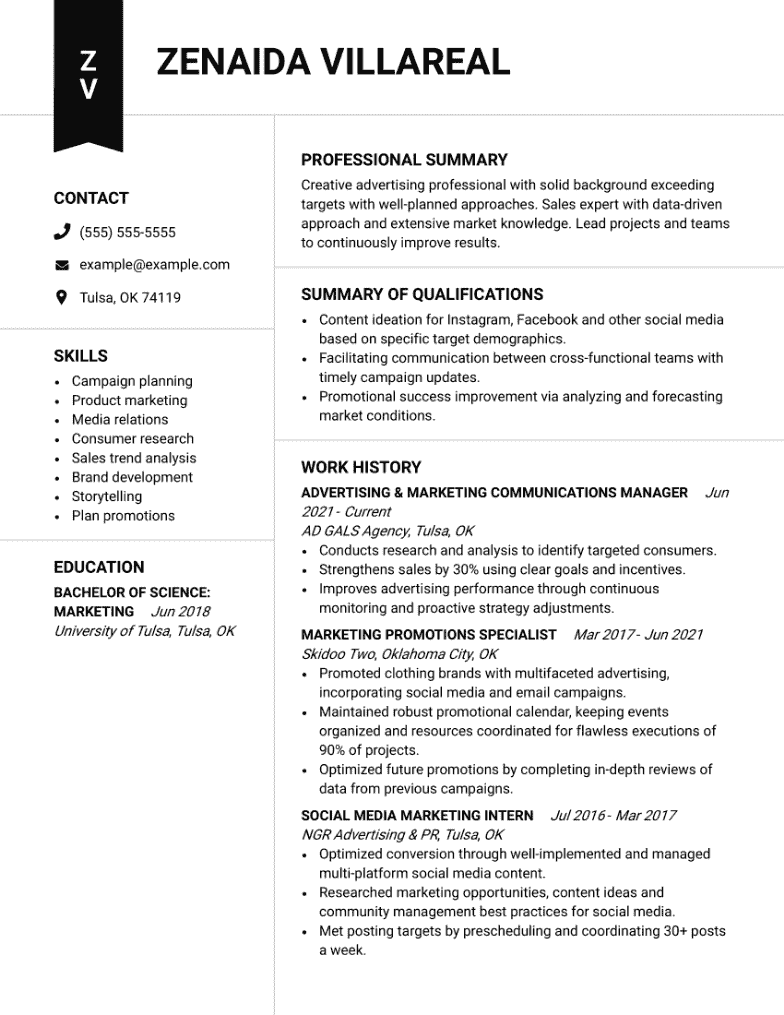Combination Resume Format Examples & Writing Guide
A combination Resume, also known as a hybrid resume, amplifies your work history and skills. It’s a good middle ground between the chronological and functional resumes — and we’re here to teach you all about it! Keep reading for expert tips on how to create a strong combination resume with examples and templates.
Our customers have been hired by*:*Foot Note

What is a combination resume?
A combination Resume is a hybrid between the functional format resume and the chronological resume. It features a work history section where you can list out your work experience and accomplishments, as well as a relevant skills section for you to use bullet points to list your skills.
A combination resume usually follows this structure:
The middle ground that a combination resume format provides is perfect for job seekers with three to eight years of experience – in other words, if you aren’t an entry-level candidate but you’re not a senior-level professional either. This resume format is also ideal for people changing careers with transferable skills; meaning that your previous work experience gave you the skills necessary to work in another industry.
Build my resumeWhy should I use a combination resume?
You should use a combination Resume format because:
- You’re a mid-level professional seeking growth in your career or searching for the same job in another company.
- You’re changing careers and have transferable skills and work experience that may apply to the new job.
- The employment gaps you have don’t exceed six months and you can fill out the work history section without leaving blanks in your career.
- It highlights skills you have that fit the job description as well as giving examples of how you’ve used these skills in previous work, you can create a professional resume that focuses on your strengths.
Combination resume vs. chronological and functional resumes
Here’s a quick guide to understand the difference between the combination resume, chronological resume and functional resume format.
| Chronological Resume | Functional Resume | Combination Resume | |
|---|---|---|---|
| Structure |
|
|
|
| Best for | Job seekers with extensive work experience and career growth. | Candidates with little to no work experience and large employment gaps. | Mid-level professionals with three to eight years of experience and career changers. |
Combination resume format: writing tips
Now that you know what a combination Resume is and why you might use one, let’s go over how it works. These are the five major sections on a combination resume:
-
Header
The first section is the header with your contact information. Typically, this will include your name, phone number, email address and LinkedIn profile, if applicable. The header will state your name in a larger font than the other elements so that everyone knows who your resume belongs to even at a glance.
-
Resume summary or resume objective
Next, you’ll want to write your resume summary or resume objective.
A professional summary statement explains to the recruiter or hiring manager who you are and gives an overview of some of your most relevant skills and achievements. It’s ideal for people with more than three years of experience who want to continue growing in their careers. For example:
Detail-oriented editor with five years of experience. Proficient in AP stylebook, Microsoft Word and Google Drive. Able to work under pressure and meet tight deadlines, revise materials in books, newspapers and websites and make suggestions based on company guidelines.
A resume objective also tells the potential employer a summary of your skills and experience but unlike the resume summary, its objective is to inform the recruiter of your goals for employment. So if you’re changing careers, you would use a resume to tell the recruiter about the job you’re seeking. For example:
Creative writer with four years of experience in the publishing industry seeking a position as an editor. Knowledgeable in AP stylebook, Chicago Manual of Style and best writing practices for fantasy genre. Able to provide industry insight, make suggestions based on genre and guide authors through the editing process.
-
Skills list
The next section is the skills section. Here is where you’ll list all your key skills, focusing especially on hard skills, soft skills and technical skills. This section uses bullet points, and for a combination resume, you’ll typically have a fair number of skills (often up to eight to 10). For example:
- Attention to detail
- Research
- Strategic planning
- Time management
- Excellent communication skills
- Good judgment
- Microsoft Office
- G Suite
- SEO
-
Work History
Next, you’ll list your job history in reverse-chronological order, with the most recent job first. Internships, volunteer jobs and other similar types of experience can go here if they’re relevant to the job. Use the work experience section to show how you used your top skills in previous jobs.
For example, if you’re applying for an administrative position, give examples of important responsibilities or achievements that show how you’ve used great communication skills, or demonstrate that you have professional experience working with office processes.
Here’s a sample of how to write an entry in the work history section of your resume. Remember to include the company name, dates of employment and location.
Freelance Writer / June 2020 – Current
The Young Herald, Portland, OR- Write opinion columns and over 50 book reviews exploring author narratives, major themes and characters.
- Edit and proofread articles for proper grammar and spelling, following company guidelines and stylebook.
- Make weekly suggestions and brainstorm ideas for engaging and unique pieces.
-
Education
The last section of your combination resume will be your education. This is where you’ll put your college education and any certifications you’ve gone through training for. Only list your high school experience if you don’t have any college experience. If you’re listing where you went to college and the degree you earned, you don’t need to list your high school and GPA.
Bachelor of Arts: English Literature
May 2018
Oregon University, Portland, ORIf you’re not sure how these sections look together, just take a look at the combination resume example featured on this page.
Combination resume templates
ResumeHelp has numerous resume templates you can use to write a combination resume. Our Resume Builder guides you through the process of creating a professional resume in minutes.
You can also refer to our hundreds of Resume examples for different jobs and industries to help you get started. You’ll find plenty of combination resume samples in our library.
Build my resumeCombination resume example
FAQ: Combination Resumes
Have questions? We’re here to help.
Is a combination Resume the best resume for me?
There’s no such thing as a single best Resume. When choosing a resume format, your best choice will always depend on the job you’re applying for and how well your skills and experiences match up. However, a combination resume might be a great option if any of these things are true:
- You have large gaps in your employment
- You have recently gone through or are looking to make a career change
- The job you’re applying for doesn’t match well with your employment history
- You’ve never had a job title the same as the one you’re applying for
If any of these apply to you, you should consider using a combination resume.
When should you avoid using a combination Resume?
There are some situations where a chronological resume or functional resume might work better. You should rethink your decision to use the combination Resume if any of these things are true:
- The job title you’re applying for is almost identical to those in your resume history
- You’re applying for a job that requires extensive experience in the same field
- You’re a first-time job seeker or lack work experience
How should I present my education section?
First off, only reference your high school graduation if you have no other education. Even then, it might be worth it to leave it off. People don’t really care about your high school graduation or your high school GPA; they just care that you graduated or got your GED. If you don’t have a college degree, don’t worry about filling out the education section.
One type of education you can definitely reference is certifications in areas that are important to what your current work is all about. If you have a number of certifications, you may want to create a new category under skills (titled “Certifications”) where you can showcase all of those credentials. The recruiter who reads your Resume will be grateful to see you have documentation that backs up your skills.
Should I explain employment gaps in my Resume?
You don’t need to explain any employment gaps in your Resume, but you may want to add a bit of explanation in your cover letter if you feel it helps your job candidacy. For example, someone applying as a health caretaker might want to mention a gap in employment where they had to take care of a sick relative. These explanations benefit your case.
In general, you don’t have to preemptively explain employment gaps. The intention behind a combination resume is to ensure that it doesn’t really matter. Your qualifications and work highlights should be enough to help a recruiter understand why you’re applying for the job. However, it’s usually a good idea to have an explanation in case the recruiter wants to ask you about it during your interview.
Couldn't find the answer you're looking for?






